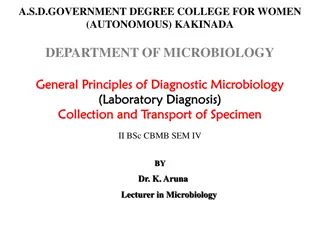Practical Bacteriology Laboratory Diagnosis and Sample Collection
This practical guide focuses on laboratory diagnosis steps in bacteriology, covering specimen collection, microscopic examination, culture tests, biochemical tests, serological tests, and molecular tests. Learn about various sample collection methods for urine, stool, swabs, sputum, pus, CSF, and mo
3 views • 23 slides
Understanding Cerebrospinal Fluid Analysis
Explore the essential aspects of cerebrospinal fluid (CSF) analysis, from routine laboratory assays to interpretation of pathological conditions. Learn about CSF formation, normal parameters, and interpretation of lab results to diagnose various neurological conditions.
0 views • 76 slides
Lumbar Puncture Procedure Overview
Understand the indications and contraindications, checklist, equipment required, needle passage layers, consent procedures, CSF testing, and key steps like patient positioning for a lumbar puncture. Learn about obtaining CSF, administering medications, measuring ICP, diagnosing CNS infections, and m
0 views • 13 slides
Understanding Cerebrospinal Fluid (CSF): Functions, Formation, and Circulation
Cerebrospinal fluid (CSF) plays a vital role in providing a controlled chemical environment, nutrient supply, waste removal, and physical support and protection to the brain and spinal cord. This fluid circulates around the central nervous system, and its formation involves processes like selective
0 views • 23 slides
Understanding Risk Mitigation Functions in Vehicle Control Systems
Risk Mitigation Functions (RMF) play a crucial role in ensuring vehicle safety by taking over control when a driver is unable to perform their driving tasks, such as in a medical emergency. This involves systems like Corrective Steering Functions (CSF) that intervene to maintain vehicle stability or
0 views • 11 slides
Understanding the Meninges, Ventricles, and CSF in the Central Nervous System
The lecture covers the cerebral and spinal meninges, emphasizing the dura, arachnoid, and pia mater layers. It explores the significance of the subarachnoid space and the ventricular system in the CNS, including CSF formation, circulation, and clinical implications.
0 views • 18 slides
Understanding CSF Rhinorrhea and Its Etiology
Cerebrospinal fluid (CSF) rhinorrhea is caused by an osseous defect at the skull base, leading to a leak due to disruption of the dura mater and arachnoid. Trauma and iatrogenic factors are common causes, with non-traumatic cases often linked to high-pressure leaks or tumor growth. Diagnosis involve
0 views • 8 slides
Introducing MatFlow: Open-source Python Tool for Computational Materials Science
MatFlow is an open-source Python code designed for computational materials science, running on HPC systems like CSF at Manchester. Users specify tasks to run in a workflow, with the main output being a workflow HDF5 file. The tool aims to make reproducibility and transparency easier, connect dispara
2 views • 10 slides
Predictive Performance of CSF A1-42 and Tau on Cognitive Decline and Dementia Progression
Analysis conducted at the Perelman School of Medicine, University of Pennsylvania, evaluated the predictive performance of cerebrospinal fluid markers A1-42, t-tau, and p-tau181 on cognitive decline and progression to dementia. The study included 2401 ADNI1/GO/2 CSF samples from individuals across d
0 views • 19 slides
Lumbar Puncture: Procedure, Complications, and Clinical Applications
Lumbar puncture, also known as LP, is an invasive procedure used to obtain cerebrospinal fluid (CSF) for diagnostic and therapeutic purposes. This procedure has a long history dating back to ancient times, with modern techniques developed in the late 19th century by Heinrich Quincke. LP is crucial f
2 views • 11 slides
Overview of CSF Physiology and Hydrocephalus Pathophysiology
The cerebrospinal fluid (CSF) plays a crucial role as a dynamic component of the central nervous system, serving as a mechanical cushion, a source of nutrition, and aiding in waste product excretion. Understanding the production and absorption of CSF, as well as factors affecting these processes, is
0 views • 46 slides
Appropriate Use Criteria for Lumbar Puncture in Alzheimer's Disease Diagnosis
Clinicians traditionally diagnose Alzheimer's Disease (AD) based on clinical criteria, but cerebrospinal fluid (CSF) AD biomarkers offer more reliable detection earlier in the disease course. This article discusses the criteria for lumbar puncture and CSF analysis in the diagnosis of AD, highlightin
0 views • 18 slides
Comprehensive Guide to Neurological Examination in Dogs and Cats
Neurological examination in dogs and cats is crucial for diagnosing nervous system disorders. This guide covers the recording of history, general and detailed clinical examinations, examination of CSF, radiographic examination, EEG, and brain biopsy. It includes assessing history, mental state, move
0 views • 20 slides
Collection and Transport of Specimens in Diagnostic Microbiology
Successful laboratory investigations depend on the proper collection and transport of specimens. This involves selecting adequate samples that represent the diseased area, avoiding contamination, obtaining specimens before administering antimicrobials, ensuring biosafety, proper documentation, and t
0 views • 20 slides
Understanding Cryptococcosis: Causes, Symptoms, and Diagnosis
Cryptococcosis is a fungal infection caused by Cryptococcus neoformans, affecting immunocompromised individuals. The disease presents with various clinical features, including pulmonary and extrapulmonary manifestations. Laboratory diagnosis involves examining specimens such as serum and CSF for the
0 views • 44 slides
Canine CSF Proteomic Profiling for Non-Infectious Meningoencephalitis Biomarker Discovery
This study focuses on using mass spectrometry to analyze cerebrospinal fluid (CSF) proteomics in dogs with non-infectious meningoencephalitis, aiming to identify unique peptide signatures for improved diagnosis and monitoring. The research addresses the diagnostic and therapeutic limitations of this
0 views • 16 slides
Research Update: Sofie's Lab Book Journey from October 2018 to December 2019
Sofie's research progress includes training on C. elegans and drosophila, meetings with various groups, preparing for conferences, and application for funding. She is focused on stem cell research, premature aging studies, and biomarker analysis in CSF.
0 views • 12 slides
Japanese Encephalitis: Overview and Management
Japanese encephalitis (JE) is a viral infection of the brain spread by mosquitoes, with symptoms ranging from mild fever to severe complications like encephalitis. Prevention is key through vaccination and avoiding mosquito bites. Diagnosis involves blood or CSF testing. Lifelong neurological issues
0 views • 9 slides

















